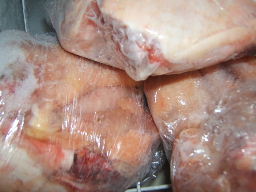Freezing Food

I love my freezer!
I do a once-a-month shop and freeze whatever I can in order to seal in freshness.
This saves me unnecessary trips to the store and I hardly ever run out of basic food stuff such as bread, milk or butter - all of this can be frozen by the way ;-)
So what else can be frozen?
You can freeze:
Cheese
Grate your cheese and freeze it in a zip lock bag.
Once frozen, it can be added to sauces, omelettes, pasta and even to snackwiches.
Or defrost as much as you will need to use on fresh sandwiches.
Vegetables
Green vegetables lose some of its nutrients shortly after being picked and continues to lose it even more in the shop and later in your fridge.
If you buy in bulk, it is better to buy frozen vegetables as it is frozen almost immediately after picking, retaining most of its nutrients.
Bread, biscuits and cakes
Bread, biscuits and even cake can be frozen and will stay fresh this way.
My children eat the biscuits straight out of the freezer as it does not freeze completely solid but merely retains its freshness.
Take cake out of the freezer a few hours before you will need it. Make sure no moisture gets into the packaging by removing the cake from its packaging / container if you think it is necessary as it can make the cake soggy.
Pre-sliced bread freezes really well and also retains its freshness. You can either take out slice for slice what you need and toast it straight from the freezer or take the entire loaf out of the freezer and defrost it overnight.
Meat stock and Sauces
Make your own
chicken stock
and let it cool down completely before pouring it in to ice cube containers and freezing it.
Once frozen, place the stock cubes together in a freezer bag.
Freeze sauces flat in plastic bags so that it won't take up too much space in your freezer.
Soups
Freeze soup flat in plastic bags, so that it won't take up too much space in your freezer.
But if you decide to freeze soup in a jar, then make sure you leave a little space open at the top, before screwing on the lid - this will allow expansion of the liquid during the freezing process.
Tomatoes and Tomato puree
- Left-over tomato puree
Once opened, freeze the large tin of tomato puree. Once frozen, place the tin in boiling water to melt the outer layer, then slide it out of the tin onto a plate. Cut it into slices, depending on the amount you'll use for stews and sauces and refreeze again.
- Too many fresh tomatoes
Cut a cross shape on top of the tomato skin and place the tomatoes in a bowl. Pour boiling water over them and leave the tomatoes in the boiled water for a few minutes. Transfer the tomatoes into iced water and pull the skin off.
Place the tomatoes in freezer bags and freeze them - now you can take them out as and when you need to add tomatoes to a stew or a pasta dish.
Herbs
Freeze fresh herbs placing them in ice cube trays, filling the trays with boiling water and placing them in the freezer.
Now you can add your herb blocks to your cooking as and when needed.
Freezer Cooking
Cook now and freeze for later.
Freezer meals can save you time and money.
Double up on your cooking and freeze half for another day. It will come in handy on those days when you really don't feel like cooking.
Here are some
freezer-friendly recipe ideas.
Freezer food facts to keep in mind :
- Avoid freezer burn by sealing food in airtight containers, wrapping it tightly in plastic wrap or by squeezing the air out of your freezer bags, before sealing it.
- Keep your freezer well stocked as a full freezer actually needs less electricity than a half full one.
- After defrosting your freezer, rub the inside out with petroleum jelly or non-stick food spray, so the next time you defrost your freezer, the ice will simply separate from the sides and fall off.
- Freeze meatballs, dough and dumplings individually - perhaps by placing them on a tray in your freezer and once frozen, storing it together in one container in your freezer.
- Separate your meat, fresh from the shop into portion sizes before freezing it. This way you only need to defrost the meat you need.
- Freeze soups and sauces flat in plastic bags so they won't take up too much space in your freezer.
Remember that liquid expands in the freezer, so when freezing liquid in bottles (juice, milk, sauces or soup), then make sure you leave a bit of space at the top before screwing on the lid.
- Freeze food at room temperature and not when it is still warm.
- Always thaw your food slowly at cold temperatures (i.e. in the fridge, overnight) as thawing it at room temperature can actually cause harmful bacteria to grow.
- Don't forget to label and date your food before freezing it. This way you won't keep food past their
freezer lifespan
and will also be better able to recognise the frozen food
[it can sometimes be hard spotting the difference between frozen soups, sauces and stocks or stews, chicken and beef casseroles ;-)]
I find being able to freeze a variety of food very liberating - as it saves me unnecessary trips to the store and also as a result saves fuel, electricity, time and effort.
Happy Freezing Everyone!
Return from the freezing food page to the Frugal Living Home






